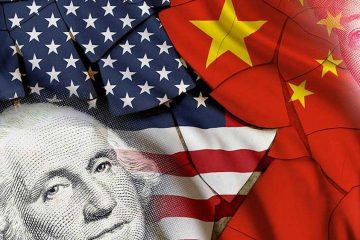Bear market cannot be averted by the Federal Reserve

The Federal Reserve is unlikely to provide a safeguard against a bear market. This week’s commentary from Wall Street regarding the Fed’s rate cut could easily fill an extensive tome, yet the essential insights into its impact on the stock market can be gleaned from an unexpected source: the film “The Wizard of Oz.”
The influential figure steering the central bank, Jerome Powell, may not possess the capacity many assume to prevent portfolio declines if the economic foundations are already beginning to falter. The initial response of stocks to Wednesday’s reduction was one of enthusiasm. That frequently turns out to be a misdirection; the conclusion of this film remains uncertain.
The initiation of the rate-cutting cycle in 2007 is noteworthy, as it commenced on the same date of the year, with an identical starting federal-funds rate, and involved a comparable reduction of half a percent (50 basis points) as observed in Wednesday’s decision. The impact was striking: The Dow Jones Industrial Average recorded its most significant increase in over four years, climbing by 336 points, which translates to approximately 1,000 points in today’s terms. Lehman Brothers shares distinguished themselves as leading performers, experiencing a notable surge of 10%.
However, it is now evident that stocks were merely three weeks away from their bull-market zenith, a recession was set to commence in January 2008, and Lehman Brothers would falter less than a year thereafter, marking the largest bankruptcy in U.S. history. By that point, the Federal Reserve had implemented six additional rate cuts—specifically, reductions of 25, 25, 75, 50, 75, and 25 basis points, sequentially. The actions resulted in rates declining to 2%, marking their lowest point in almost four years. In the two months subsequent to the Lehman panic, the Federal Reserve implemented three additional significant reductions, bringing interest rates down to zero (specifically a range of 0% to 0.25%) for the first time in history.
The benchmark S&P 500 experienced a notable increase, rising by 4.7% during that period. The Dow’s increase of 360 points would equate to almost 1,700 in today’s terms. However, they completely reversed the gains from that day’s rally within a week and subsequently lost an additional quarter of their value before reaching a low in March 2009.
The circumstances surrounding the housing crisis were unprecedented, triggering the most severe economic contraction in the United States since the Great Depression. Rare by nature, extreme events often lead to predictions of catastrophe that ultimately prove to be unfounded. More capital is forfeited in anticipation of bear markets than during their actual occurrence, even when they materialize.
Over the past century, there have been 22 bear markets, each arising from a variety of factors. Those who disregard the potential for a downturn simply because particular excesses—such as toxic subprime loans reminiscent of the mid-2000s or absurd dot-com valuations from the late 1990s—are absent today may find themselves in a precarious position. Similar to military leaders who cling to outdated strategies, they excessively depend on their past experiences.
In a notable instance within the field, David Malpass, then chief economist at Bear Stearns, authored a Wall Street Journal op-ed titled “Don’t Panic About the Credit Market” in August 2007, following a two-month decline in stock prices.
“In contrast to the 1998 disruption in credit markets that many are currently referencing, the pools of global liquidity are abundant, rather than depleted as they were at that time,” he stated. “The profound crisis of 1997-1998 in Asia has been supplanted by a robust economic expansion.”
In the wake of five successive reductions in the Federal Reserve’s interest rates, his employer emerged as one of the initial prominent victims of the credit crisis. Two months into the rate-cutting cycle that commenced in September 2007, sentiment had notably soured. Nevertheless, a survey conducted by the Wall Street Journal among 54 economists during that period indicated that the likelihood of a U.S. recession occurring within the next year stood at merely one-third.
The chairman of the Federal Reserve lacks the ability to conjure an economic revival for a faltering economy or to prevent a stock market poised for decline. David Kostin, a strategist at Goldman Sachs, recently observed that “the trajectory of growth is a more important driver for stocks than the speed of rate cuts.”
Research indicates that when the economy is already trending towards recession prior to the initial rate cut, the median trajectory of the S&P 500 typically results in a loss of approximately 14% of its value over the subsequent year. If it is not approaching a recession, then it must be the opposite. Reduced interest rates undoubtedly hold significance for bond investors. They may merely mitigate an already-declining trend in equities, given the protracted time required for effects to permeate through to businesses and consumers.
The assertion that the U.S. economy may soon experience contraction lacks compelling evidence at present, and a significant decline of a third or more in stock values would be atypical unless economic activity were to falter. This elucidates the current proximity of stock values to historic peaks, alongside the muted indicators of typical market apprehension. However, there exists a flawed assumption that reductions by the Fed inherently justify a sense of tranquility and continued purchasing activity.
Intelligent voices on the periphery, as is often the case at this juncture, are sounding alarms regarding the overextensions in private credit and commercial real estate, as well as the implications of China’s concerning economic deceleration on the global landscape. U.S. equities find themselves at an unprecedented juncture, characterized by elevated valuations, a high degree of concentration, and a pronounced reliance on a singular narrative—the potential of artificial intelligence. Global government indebtedness has reached unprecedented levels, complicating the response to the forthcoming recession.

